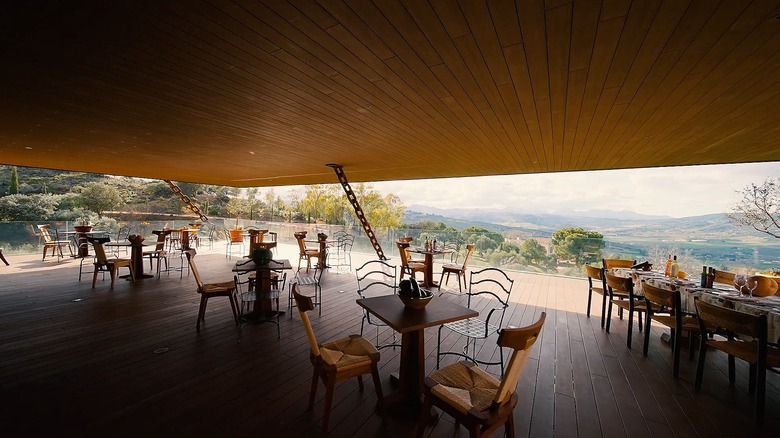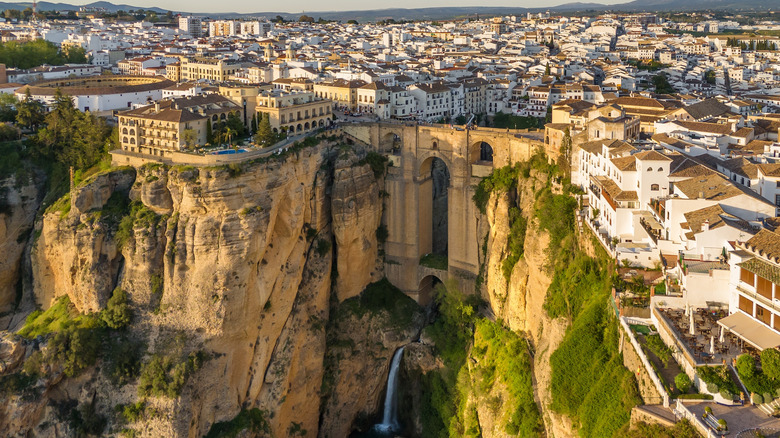Spain's Olive Oil Museum Is A Strange And Surreal Destination Amid Magical Grove-Covered Hills
In the romantic, cliffside, whitewashed city of Ronda, Spain, a new attraction is poised to attract visitors from across the globe who appreciate design, art, food, and nature. LA Almazara produces olive oil but it is so much more than a mill. The expansive property has photography and other museum art forms on display, groves of trees where 20 kinds of olives grow, gardens to explore, and a restaurant. What really makes it stand out, though, is its design. The brainchild of one of the world's most creative people, Philippe Starck, LA Almazara is a striking architectural statement enhanced by dramatic design elements that refer to its location and subject. It's fitting that the design is surreal in nature as Ronda's region of Spain, Andalusia, has a connection to Surrealist artists like Dalí and Miró. Starck is an architect and also a designer of many things from a lemon juicer and teapot to an airport control tower and wind turbine. He is perhaps best known for designing hotels, restaurants, and bars — like the Faena Hotel in Buenos Aires — that immediately get the attention of design publications.
A magical region of tree-covered hills, monumental archaeological sites, and cobblestone streets, Ronda is one hour and 15 minutes by air or six hours by car from Madrid. In the south of Spain, it is closer to the Mediterranean beaches of the Costa del Sol like Málaga, around a one-hour drive away. Note that public transportation to LA Almazara is limited, so this is a perfect destination for a road trip.
LA Almazara visitor experience
After parking at LA Almazara, you pass a photography exhibition on the way to the Greenhouse. Here, a short video introduces the history and process of olive oil production and this is also where you'll find a restaurant, shop, tasting room, and mill. Walk by vegetable and fruit gardens as well as a vineyard growing pinot noir before reaching the olive grove. All produce is organically grown and the olives are handpicked and low in acidity. The conclusion of the visitor experience is an olive oil tasting, where you'll learn to identify the flavors of different varieties; you can pair a tasting with artisanal bread, cheeses, and local delicacies. LA Almazara is also developing visitor experiences like workshops, concerts, and food events.
The first aspect of Philippe Starck's avant-garde design that visitors will notice is that the Greenhouse is a red cube with one enormous horn. The horn is a reference to Spain's tradition of bullfighting, as Ronda is its birthplace, and the giant eye is a nod to Surrealism. Inside, a massive half olive is a reminder that you're in an olive oil factory and a pipe and funnel overhead reference oil production. A portrait of a bullfighter and an exaggeratedly large bullfighter's sword also tie back to Ronda's famous cultural expression, bullfighting. Starck's design juxtaposes the perennially sunny landscape outside with a cool, dark interior meant to protect the delicate olive oil production process. A terrace suspended by metal chains connects both worlds and adds to the surreal atmosphere.
Exploring Ronda
Ronda's remarkable natural beauty, culture, history, and gastronomy make it an enticing city to explore. Perched atop a deep gorge, Ronda is known for a number of attractions, but no visitor should leave without a photo of the Puente Nuevo (New Bridge). This iconic 18th-century bridge spans the 120-meter-deep El Tajo gorge, connecting Ronda's old and new towns. Offering breathtaking views of the surrounding tree-covered hills and clusters of white homes, it's a must-see landmark. Wandering the narrow cobblestone streets of the Old Town (La Ciudad) with its historic churches and charming plazas transports visitors to centuries past. The well-preserved 13th century Baños Árabes (Arab Baths) showcase intricate Moorish architecture, a striking example of Islamic heritage. Remnants of the city's defensive walls and gates, such as the Almocábar Gate, reflect Ronda's strategic importance during the Moorish period.
The birthplace of modern bullfighting, Plaza de Toros is one of Spain's oldest bullrings. A museum on site discusses its cultural significance and history. Ronda was home to the Romero dynasty of matadors who developed the rules of bullfighting and there's a statue of Ernest Hemingway here. Two impressive buildings also warrant a visit. Mondragón Palace, which was formerly a royal Moorish palace, now houses the engaging Municipal Museum. Both the museum and La Casa del Rey Moro have beautiful gardens with panoramic city views.
Spain is one of Europe's best destinations for a road trip — don't forget your International Driver's Permit, and definitely include Ronda on your itinerary!


